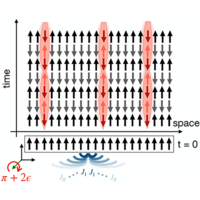Abstract
Discrete time crystals represent a paradigmatic nonequilibrium phase of periodically driven matter. Protecting its emergent spatiotemporal order necessitates a mechanism that hinders the spreading of defects, such as localization of domain walls in disordered quantum spin chains. In this work, we establish the effectiveness of a different mechanism arising in clean spin chains: the confinement of domain walls into “mesonic” bound states. We consider translationally invariant quantum Ising chains periodically kicked at arbitrary frequency, and we discuss two possible routes to domain-wall confinement: longitudinal fields and interactions beyond nearest neighbors. We study the impact of confinement on the order-parameter evolution by constructing domain-wall-conserving effective Hamiltonians and analyzing the resulting dynamics of domain walls. On the one hand, we show that for arbitrary driving frequency, the symmetry-breaking-induced confining potential gets effectively averaged out by the drive, leading to deconfined dynamics. On the other hand, we rigorously prove that increasing the range of spin-spin interactions beyond nearest neighbors enhances the order-parameter lifetime exponentially in . Our theory predictions are corroborated by a combination of exact and matrix-product-state simulations for finite and infinite chains, respectively. The long-lived stability of spatiotemporal order identified in this work does not rely on Floquet prethermalization nor on eigenstate order, but rather on the nonperturbative origin of vacuum-decay processes. We point out the experimental relevance of this new mechanism for stabilizing a long-lived time-crystalline response in Rydberg-dressed spin chains.
9 More- Received 30 November 2021
- Accepted 1 August 2022
DOI:https://doi.org/10.1103/PhysRevX.12.031037
Published by the American Physical Society under the terms of the Creative Commons Attribution 4.0 International license. Further distribution of this work must maintain attribution to the author(s) and the published article’s title, journal citation, and DOI.
Published by the American Physical Society
Physics Subject Headings (PhySH)
Popular Summary
Characterizing the physical ingredients that prevent systems of many interacting quantum particles from relaxing to thermal equilibrium constitutes an intense ongoing research effort. From the theory perspective, this is a stepping-stone to understand phases of matter whose existence is forbidden in equilibrium conditions. From the experimental perspective, this may allow one to protect and manipulate quantum information, which is a crucial step toward the development of quantum technologies. Here, we envision a novel mechanism to stabilize a prime and fascinating nonequilibrium phase: a time crystal.
Time crystals are characterized by the spontaneous breaking of time-translational symmetry, which had long remained elusive because of the subtle role played by the temporal dimension in physics. Current proposals and realizations of time crystals involve quantum spins periodically driven at high frequency and featuring either strong disorder or long-range interactions. These features are often hard to access and control in current atomic, molecular, and optical experimental platforms.
Our mechanism to stabilize a time-crystalline response does not require these ingredients. The proposal is based on the confinement of elementary excitations—a prototypical phenomenon of high-energy physics, which also plays a relevant role in low-dimensional lattice systems. We demonstrate that a weak confinement of topological excitations can protect spatiotemporal time-crystalline order for extremely long times.
This work introduces a new theoretical idea in the widespread effort to stabilize nonequilibrium phases of matter, which paves the way to the observation of time-crystalline collective behavior in scalable atomic arrays with interatomic interactions controlled via highly excited (Rydberg) states.



